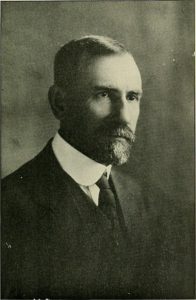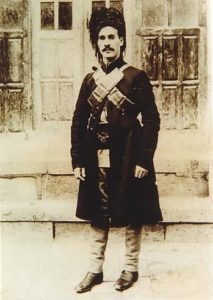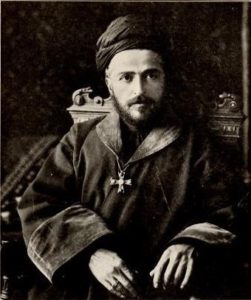By Denise Hassanzade Ajiri
As the end of World War I approached, William Ambrose Shedd, the American Presbyterian missionary since 1892 in Urmia, the capital of Persia’s West Azerbaijan province, became the American consul in the city. The journal of his wife, Mary Lewis Shedd, provides a first-hand view of how the one of the least-known campaigns of the Great War tore the region apart.
West Azerbaijan shared a border with the Ottoman Empire. During the war, the area became the arena of a complex conflict between the Ottomans, British forces operating in Persia, and local religious and ethnic groups. Early in the war, when the Ottomans made progress, they attacked local Assyrian and Armenian Christians and drove them from their lands.
In 1918, the war again brought bloodshed to West Azerbaijan, but this time, as Mary Lewis Shedd wrote in her journal, Muslims were the victims.
Feb 24, 1918:
“The wheels of time seem suddenly to have turned backward three years and we find ourselves in somewhat similar conditions as at that time of the Turkish siege, only not nearly so bad as yet, and Christians are the victors this time.”
 William Ambrose Shedd
William Ambrose Shedd
Populated by Sunni Kurds and Assyrian and Armenian Christians along with the Shi’ite Azeri majority, West Azerbaijan has always been a mix of different cultural and religious communities. It was in such environment that American Presbyterian mission was founded at Urmia in 1835, mainly to work with Assyrian Christians. But in 1918, while still feeling obligated to serve the Assyrians and bring peace to Urmia and its surrounding villages, Mr. and Mrs. Shedd could not disregard the massacre of the Muslims by hardline Christians.
Feb 22, 1918:
“This morning… I saw a group of mullahs and others coming into our yard with several white flags, and one green one with a white rag tied to it… I counted them until they ran up to about 300 and then gave up… It was a strange and stirring sight to see this big band of the chief men of a Moslem city of 50,000 inhabitants surrendering themselves and their city to a few hundred Christians …”
During this chaotic time, Mar (an honorific title, meaning “my lord”) Shimon Benyamin, the leader of the Assyrians, along with other Christian leaders were trying to agree upon terms of peace with Muslims leaders. One of the Muslim leaders was Simko Shikak, the leader of a Kurdish tribe, who seemed like to be on the side of the Christians.
March 10, 1918:
“Simko, the Kurdish chief, seems to want to show himself the friend of Christians, and refuses to fight against them, even though ordered to Urmia for that purpose.”
But as Mary Lewis wrote in her journal that “one always has the feeling that nothing is permanent, and there is danger of sudden turn of affairs,” things changed rapidly.
 Simko Shikak
Simko Shikak
On March 2, 1918, Simko who had earlier suggested that Assyrians and Kurds should resolve their differences, invited Mar Shimon to Kuhnashahir (Old City), three miles northwest of his home in the town of Khosroabad.
The next day, Mar Shimon along with around 150 of his riders met with Simko in the Old City and talked about uniting forces. After the meeting as Mar Shimon was getting back into his carriage, Simko’s men start firing at them.
 Mar Shimon Benyamin
Mar Shimon Benyamin
It took a while for the news to reach Urmia, nearly 50 miles south. On March 19, Mary Lewis Shedd wrote:
“Yesterday we got word through Kurds that Mar Shimon and Shmoel Kha[n] and 60 of their guard had been treacherously murdered at the Old City of Salmas. Simko, the Kurd, who has been pretending friendship for the Christians, called his men and Mar Shimon to Old City for a conference. After the conference Mar Shimon and his men were killed by Simko and his men.”
By March 23, she’d learned more:
“Things have been very lively here since the word came of the murder of Mar Shimon. A hundred and twenty of the 150 men who went with him were killed by Simko’s men and the Moslems of Old City. It was a most treacherous business. After fnishing a conference with the agents of the Vali Ahd [governor of the district of Diliman] who had invited him to [the district capital] Diliman, Mar Shimon was invited by Simko to meet him in Old City an hour or so from Diliman for consultation. After they had finished their conference, just as Mar Shimon was stepping into his carriage, he and his men were fired upon from every direction by both Simko’s men and the Moslems of Old City. Mar Shimon had five bullets wounds.”
When the news of Mar Shimon’s assassination reached the Assyrians of the Urmia area, they didn’t remain silent.
March 23, 1918:
“When the mountaineers [Assyrians who lived in the mountains] here were sure that the report of the murder of Mar Shimon was true they started to take their revenge. On Wednesday, two or three hundred Kurds and Moslems were killed and many houses robbed.”
The war among Kurds and Christians lasted until the end of July 1918 when Britain’s Urmia front collapsed and Ottomans took control of the region.
On July 31 and August 1, 1918, the majority of the Christians along with William Ambrose
and Mary Lewis Shedd fled the area. Thousands of the people, including William Ambrose died of cholera along the way. Mary Lewis made it to Hamadan, more than 250 miles south of Urmia. On September 24, 1918 while in Hamadan, Merry Lewis recounted her husband’s death the previous month:
“…When the light began to reveal things, I could see the awful change in his face, but I could not believe that he was leaving me. Shortly after light the men told me that we could not wait as they heard fighting behind and it was evident the English were attacked, so in his dying hour we had to take him over the rough, stony road. After an hour or to Capt. Reed and the doctor caught up to us. We drew the cart to the side of the road where soon he drew a few short breaths – and I was alone.”
William Ambrose who was born of missionary parents in Urmia in 1865, died in early August in Zanjan province, 200 miles south-east of Urmia.
In October 1918, two months after William Ambrose’s death, the Ottomans retreated from Iran and a month later the World War I ended.
Mary Lewis, bearing her diary, eventually escaped to Iraq and later returned to the United States.
Kurds have always been back stabbers and treacherous dogs that is why they never had a state in the history of this world. I am not surprised
This is all a lie. It is clearly obvious that it was written by a second class turk. Simko was a man of honor and this was all a setup to damage his reputation and his friendship with the assyrians. And speaking of treachery, don‘t forget what the assyrians did to the Med (Kurds) 700 B.C.